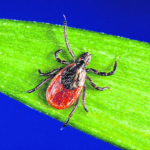Game commission: Reducing deer population not likely to stem spread of Lyme disease


Share this post:
For Ryan Johnson, Pennsylvania’s white-tailed deer are more than just a potentially dangerous nuisance.
“Deer in Pennsylvania are playing a huge part in ruining lives and costing people major money through accidents and disease,” said Johnson, of Norvelt. “Lyme disease is a big deal and doesn’t get the attention it should, and neither does this whole deer problem.”
Johnson and two other friends were bitten by Lyme-carrying ticks in June at different locations in Westmoreland County. The state should be doing more to manage the deer population, including extending the hunting season, he said.
Officials with the Pennsylvania Game Commission, however, say the problem is more complex.
“We’re never going to get rid of the ticks by managing deer,” state game warden Chris Bergman said. “We’re not specifically doing deer management to address the tick.”
Pennsylvania’s white-tailed deer population has grown from about 10 deer per square mile in the 1700s to an estimated 30 deer per square mile today, according to the state’s Department of Conservation and Natural Resources.
And, while Lyme disease is a concern, both Bergman and game commission wildlife management supervisor Samara Trusso said the commission’s primary concern is chronic wasting disease.
“One of the primary vectors for Lyme transmission is small mammals like white-footed mice,” Trusso said. “I know the ‘deer tick’ has really put the target on deer, but we would still have Lyme transmission and tick movement without them.”
Unlimited solution?
Johnson said he likely would have continued to receive an incorrect flu diagnosis if his tick bite hadn’t, after four days, bloomed the classic, red bull’s eye.
“Everybody just keeps dealing with it, but let the citizens that want to hunt (deer) do it all year long in unlimited numbers until the population gets to a reasonable number,” he said.
Unlimited deer hunting, however, is the reason the Pennsylvania Game Commission was formed.
By the late 1800s, unregulated hunting had driven the state’s deer population dangerously low. The game commission formed in 1895, according to DCNR, establishing the state game lands where many hunters flock during deer season.
When it comes to the road, Pennsylvania is among three states where drivers are most likely to have a collision with wildlife, according to State Farm’s annual analysis. Drivers here have a 1-in-52 chance of hitting an animal — most likely a deer.
Lyme dilemma
While population reduction measures could potentially lower that number, Trusso said it is not likely to change Pennsylvania’s status as the state with the most annual Lyme incidents.
“There have been studies in New England where they’ve reduced the deer population and not found a change in Lyme transmission or its occurrence in small mammals,” Trusso said.
There were just over 10,200 cases of Lyme disease reported in Pennsylvania in 2018, the first drop in recent years. The state had 11,900 cases in 2017. Of that total, Westmoreland County was the third-highest in the state with 496 cases, behind Butler (624) and Chester (678) counties. Westmoreland’s numbers declined for the third year in a row, down from 577 cases in 2016.
Trusso said the commission recommends the use of bug repellents containing permethrin for those venturing into tick-populated areas.
Johnson would like to see additional efforts.
“Figure something else out,” he said. “Deer are, unfortunately, nothing but pests at this point.”



